Olly Thompson spent a week heli fishing in Tsimané in Bolivia last autumn. His trip report is a great read. If you’ve got a few minutes, grab a cup of coffee and immerse yourself in an extraordinary angling experience! Over to you Olly:
If you inquire with any avid angler about their dream destinations, Tsimané in the heart of the Bolivian jungle is bound to be a recurring theme. It has earned a remarkable reputation as a place that reshapes one’s perspective on what constitutes a significant and unforgettable trip. Having previously fished and guided for golden dorado in northern Argentina, I had caught wind of tales from friends who had ventured into Bolivia, claiming that this experience was an entirely different beast. Imagine crystal-clear rivers resembling the trout streams of New Zealand, winding their way through the thick, untamed jungle and a plethora of hard fighting and colourful species.
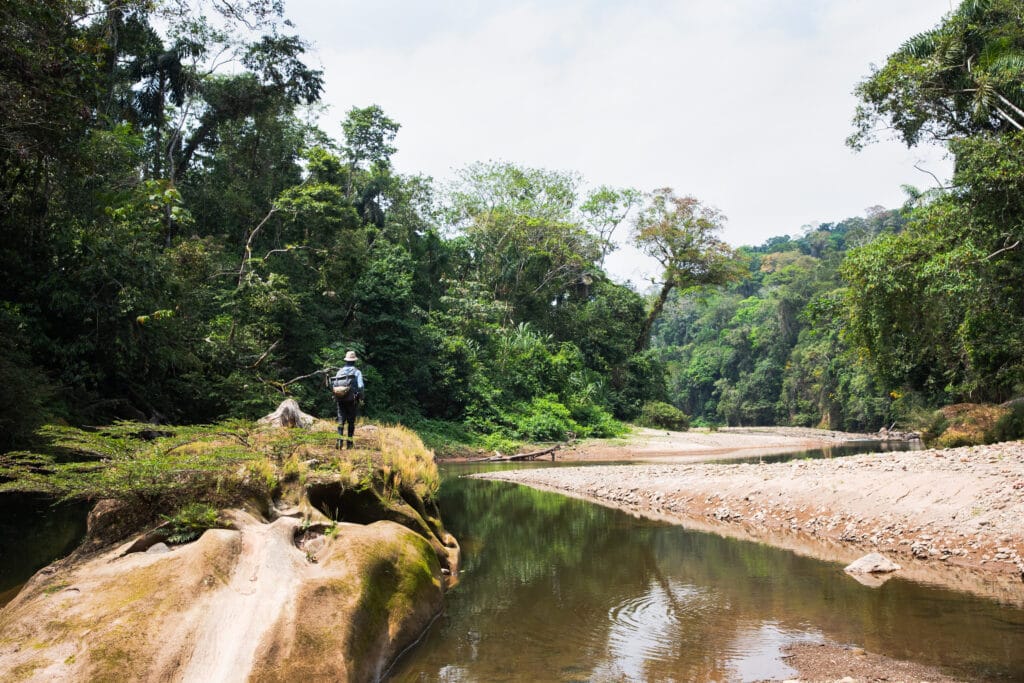
Embarking on a journey to a remote and distant destination typically involves meticulous planning and months of consideration. However, this time around, it was different. When presented with the opportunity to explore Tsimané’s new heli programme with only a few weeks’ notice, my decision was swift. Spontaneous travel also translated to a last-minute scramble for a flight to Santa Cruz, the city signalling the start of my journey on the flip side. Though my ticket boasted Iberia Airlines, it was merely a façade; the bulk of the travel was entrusted to Bolivian Airways.
A restful night at the Los Tajibos Hotel in Santa Cruz, complete with a satisfying breakfast, marked the perfect prelude to an adventure I had envisioned for years. Flights, cosy hotels, and some driving seemed dim formalities compared to the prospect of the wildness of the jungle. The internal flight turned out to be shorter than expected, and we soon touched down on the dusty landing strip in the village of Oromono, a modest indigenous community nestled at the foothills of the Bolivian Andes. Stepping off the plane, we were enveloped by the thick jungle air, a cacophony of sounds from the vibrant bird and insect life, and the wide grins of local children who eagerly inspected the newcomers.
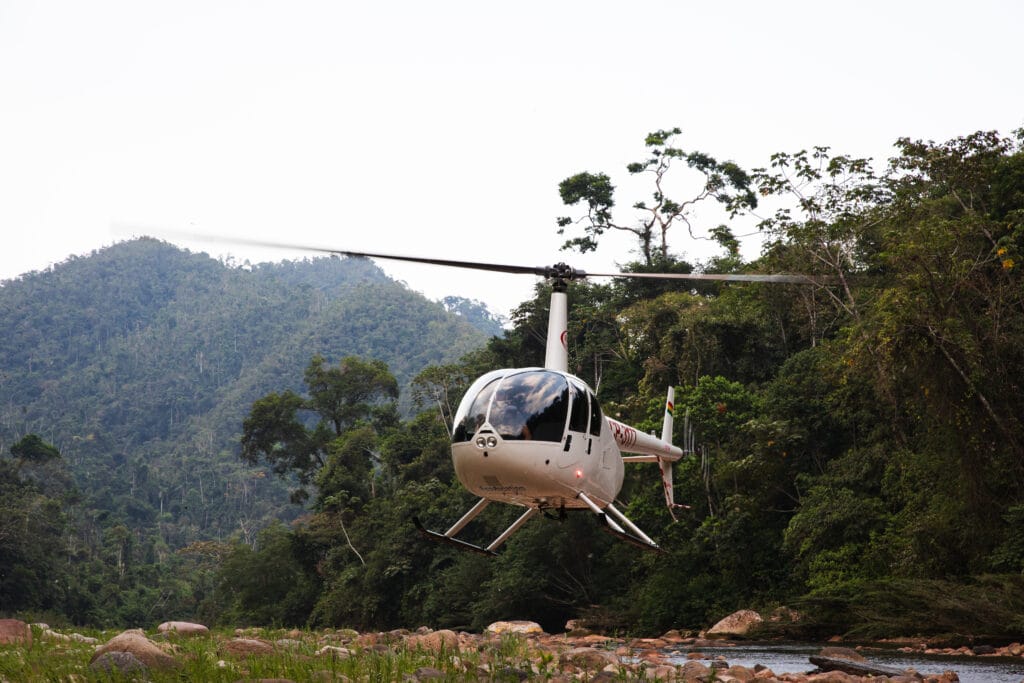
The usual journey for Pluma Lodge guests is to navigate upriver in dugout canoes, but a four-seater Robinson R44 was waiting for us. Rising above the treetops, we soared toward the setting sun, which painted the mountains in shades of red and amber, evoking scenes reminiscent of Apocalypse Now. The jungle sprawled beneath us like a lush green carpet, occasionally punctuated by flashes of electric blue from flocks of macaws returning to their roosts for the night.
While Pluma Lodge’s regular programme concentrates on exploring the River Pluma and the lower sections of its main tributary, the Itirisama, the helicopter programme unveils opportunities to prospect an abundance of remote water. For our guides, Nico and Juan Pablo, the helicopter was a key to exploration, a means to discover those little-known rivers that are nothing more than a vein of clear water on Google Earth. The heli programme accommodates four guests at a time. However, I played the role of the tag-along fifth on this journey, sharing most of the days with a straight-talking and enjoyable Aussie named Dizzie and an experienced Brazilian jungle angler named Breno.
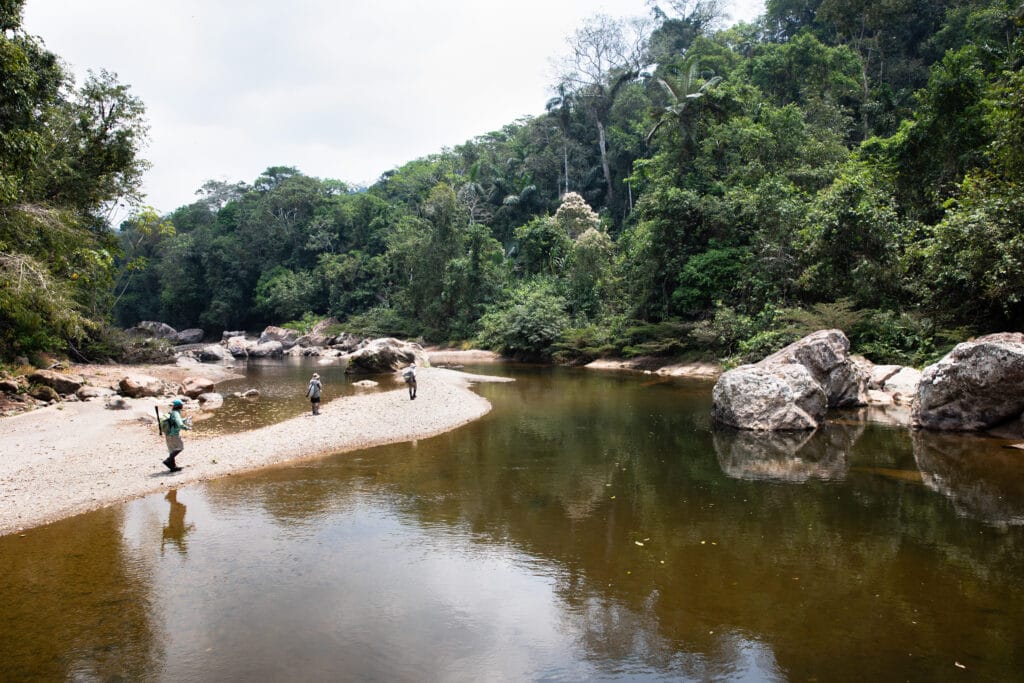
Our introduction to the heli fishing programme unfolded on the upper reaches of the Pluma. In a manner reminiscent of trout fishing, Dizzie and I stealthily moved upstream, our footsteps hushed on the soft sand, and we trod lightly on the small rocks with quiet finesse. This style of fishing resonated with me, a blend of hunting, spotting our way upstream, and scanning the clear water for glimmers of gold or the slate-green back of a dorado. Nico’s eyes where finely tuned to discern the subtleties between fish and riverbed. “Top of the run on the right side of the boulder. Cast and strip fast,” he directs. Dizzie throws a tidy line, and the black streamer lands with a subtle plop near the rocky edge. Suddenly, from the green depths, the water erupts. “Strip, strip, strip!” echoes the command from behind. Dizzie is hooked up, and the fish is airborne, showing acrobatic prowess. The sun catches its striped golden flank. I couldn’t help but revel in my love for these remarkable fish. The battle was brief but lively, and soon, my newfound Aussie friend was cradling his golden toothy prize. “How about that?” I say. “Bloody awesome, mate! One hell of a fish.”
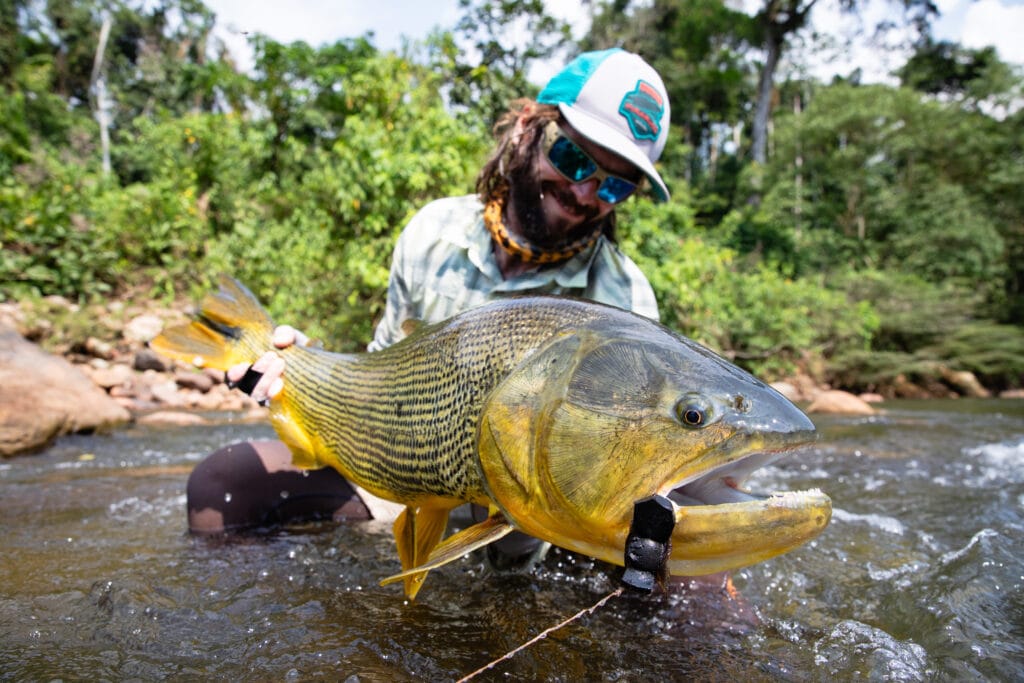
Upstream from Nico and Dizzie I find myself at a slow, deep pool framed by a high rocky outcrop on the far bank. The riffle at the top collides with a car-sized boulder before transforming into a large eddy just below. I prospect the deep water to entice a take from the structure below, but nothing. Treading quietly, heel first, I move to the faster water at the top. The first strip through the riffle is welcomed by a following black shape. A pacu. The fish follows into the eddy, keeping pace with the streamer but hesitating to commit. I stop, and it comes closer, nosing the fly in the soft bottom. A short, sharp pluck and then the pacu sips the fly down. On setting the hook with a swift strip, the fish tears line from my fingers and makes a beeline for the pile of sunken debris downstream of the large boulder. Now, on the reel, I crank the drag as tight as I dare and stop it just in time to prevent getting cut off. A spirited tussle ensues, but each run is less, and soon, the black dinner plate is settled in the sandy shallows. Plenty of parallels between this pacu and the triggerfish I have caught in Seychelles can be drawn. Their sneakiness, distinct personalities, and, above all, their dogged strength.
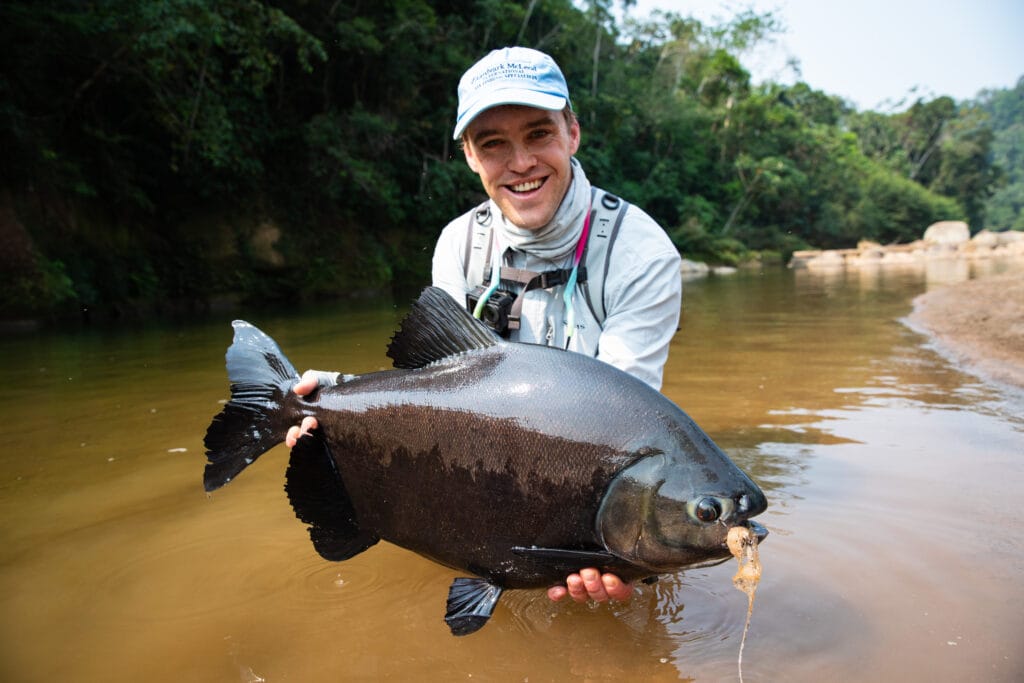
JP approaches us the following morning as we enjoy coffee amidst the jungle’s symphony on the slatted front deck. He asks if we were keen on exploring the uncharted upper reaches of the Pluma. This untouched territory promised a unique opportunity to scout small waters and cast at dorado that had never seen flies. Upstream, the Pluma transforms into a boulder-covered and intimate landscape. Unlike the longer glides we had fished the day before, this area features pocket water, with rock-hopping from one small pool to the next. The fish are unpressured and enthusiastic, not particularly large but offer great fun on chunky dries. Besides dorado, this stretch of the river houses good numbers of yatorana, a fiercely strong smaller fish resembling an overgrown, toothy, and colourful roach.
As we round the bend, JP lifts his hand to signal stop. Walking towards us is a female tapir with its calf. The tapir sticks its elongated snout in the air, wiggling it from side to side; it can sense a whiff of the unusual. Tapirs have notoriously poor eyesight and can be curious creatures, especially when encountering humans for the first time. To capture her attention, JP whistles. The tapir turns, and to our amazement, follows the sound. Another whistle. The tapir came closer, disappearing underneath the water before resurfacing within casting distance. Another whistle, and she comes even closer, sniffing the air again. She is less than ten metres away. We stand still, careful not to breathe too heavily for fear of concluding this remarkable encounter.
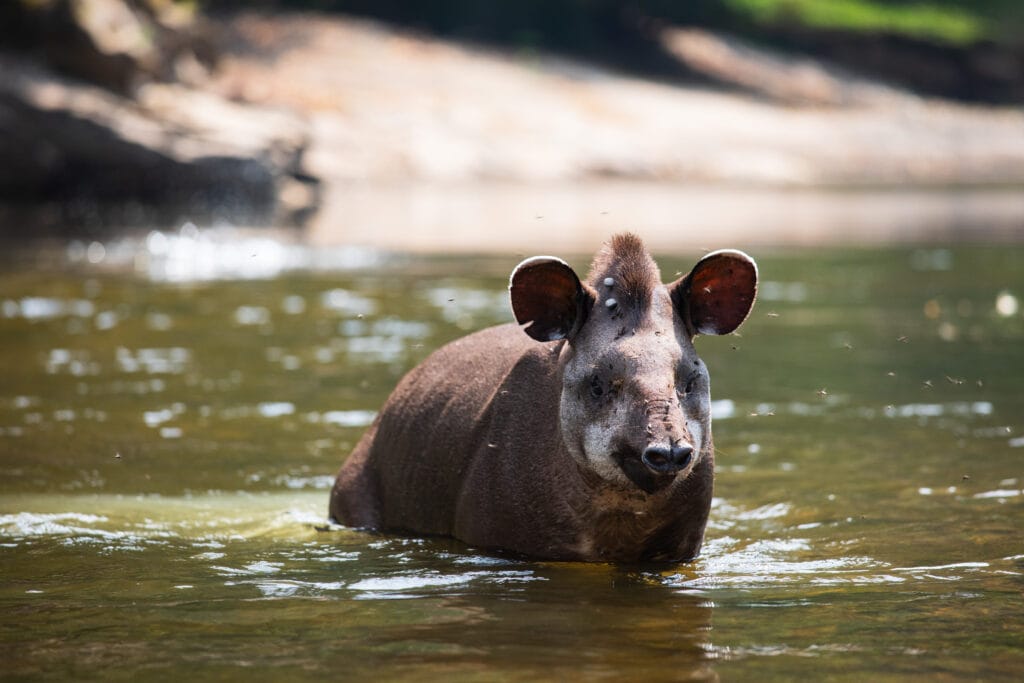
The Itirisama has always been celebrated as the crown jewel in the Pluma Lodge programme, as the river is renowned for its stunning environment and technical clear-water fishing. As Chucky, the lodge manager, and head guide Alejandro were joining us for the day, I knew that venturing into the upper reaches of this mythical river would be a unique experience. The Itirisama runs clearer than the Pluma, allowing sight fishing in almost all the pools. It is a place that demands a delicate approach, with each fish requiring careful stalking. We soon find that fishing this section of the Itirisama is not for the faint of heart, as much of the river flows through steep-sided gorges, and the only way to move upstream is to swim. Swimming a considerable distance with all your gear and heavy wading boots is no easy feat, but employing the proper technique can make it more manageable. Wearing the backpack on your front serves as a flotation device, and you can tuck your rods on top under your chin. I relish this kind of fishing, which is uncompromising, unforgiving, and exploratory.
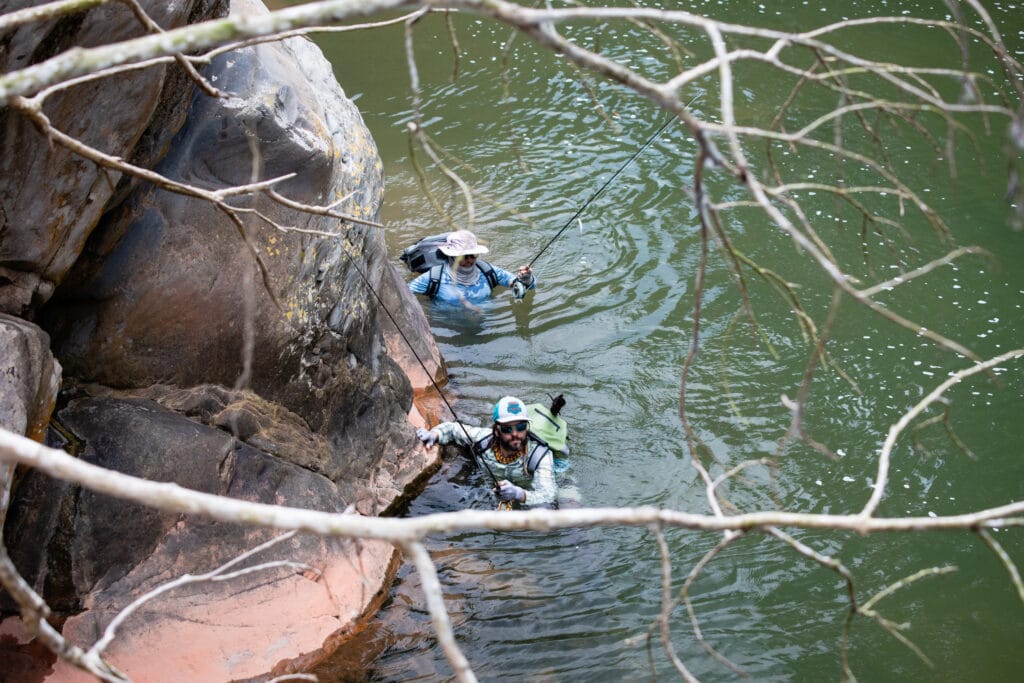
If a pool looked promising, it held fish. These were formidable residents with greenbacks and robust shoulders; all seemed in the double-figure range and beyond. Armed with my camera, I took on the role of a spectator rather than an angler. Now, it was time for Dizzie and Breno to take centre stage. On scaling a smooth, grey outcrop sculpted by years of relentless currents, I spot two large dorado positioned like trout at the tail of the smooth green pool below. Crouching low to remain unseen, I secure the best vantage point to witness the impending spectacle. Using rod lengths, I describe the precise position of the fish to Chucky and Dizzie. The take is so instant that it seems the dorado tracked the fly as the loop unrolled from the final delivery. The smaller of the two breaks the surface with an impressive jump, the fly in the corner of its mouth. Sensing the disturbance, other dorado from upstream join, and soon, a pod of five launch an attack on the hooked fish. I witness every detail of each fin and tooth, marvelling at one of the most aggressive freshwater predators in all its glory. However, as quickly as the fish took the fly, it comes loose, leaving Dizzie with a tangled mess of slack line at his feet.
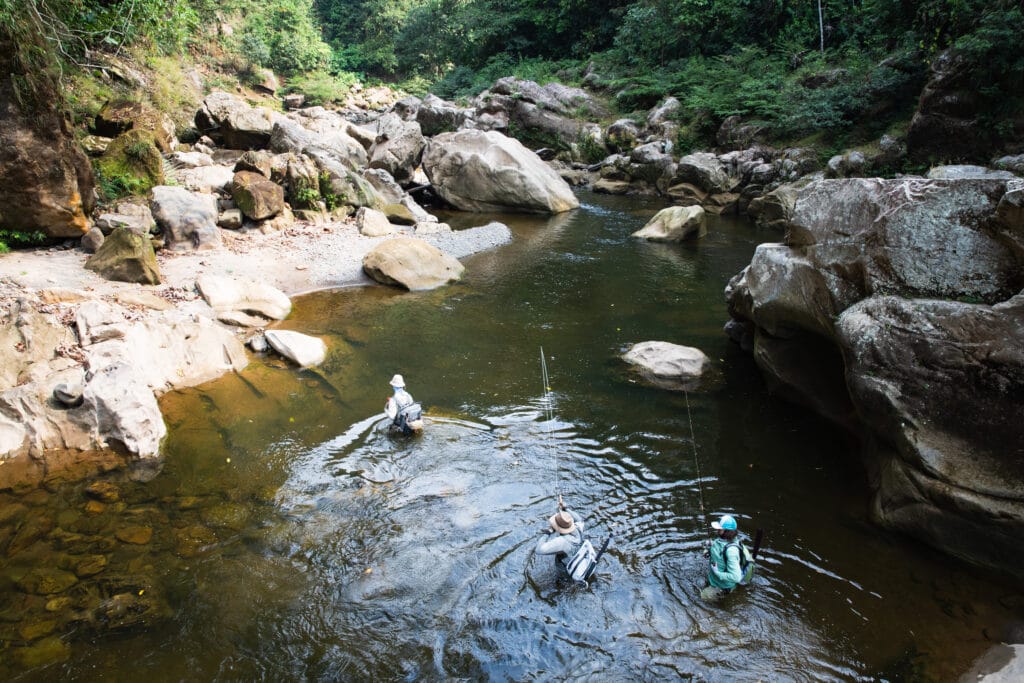
We swam and explored for the remainder of that day, and the boys cast their lines. The journey was far from easy, but the juice was worth the squeeze as almost every pool presented opportunities to hook up with big dorado. Among all the places we fished, the Itirisama stood out as the one I would run back to more than any other, no matter the distance. The vivid images of that day are etched into my consciousness, destined never to dull or fade. Even though I wasn’t actively fishing, the river embodied everything I could have hoped for from Bolivia. This sentiment was crystallized at the end of the day when, in an impossibly beautiful pocket, I couldn’t resist making a few casts before our pickup. Second cast a monstrous dorado surged after my fly, its head half out of the water, reminiscent of a GT.
Describing the heli fishing at Tsimane would be better suited to a book rather than a brief account, as encapsulating an experience so rich with so few words is challenging. Travelling to Pluma Lodge and participating in the heli programme was about more than targeting dorado, pacu, and other unique and wonderful species. It was about being fully immersed in a place untouched by man’s hand that so few get to see. A place where you walk through clouds of multi-coloured butterflies beside clear waters, enveloped in a canopy of green dense jungle, a jungle alive with noise, teeming with life and pulsating with energy.
Fishing aside, this is an experience like no other. The flora and fauna of this remote part of Bolivia is rich and diverse. Make sure that, alongside your tackle and many flies, you room for a good pair of binoculars. Working with the local communities to preserve and conserve this unique habitat is key, and without the interest of travelling anglers the chances of this remaining wild and untouched diminish greatly.
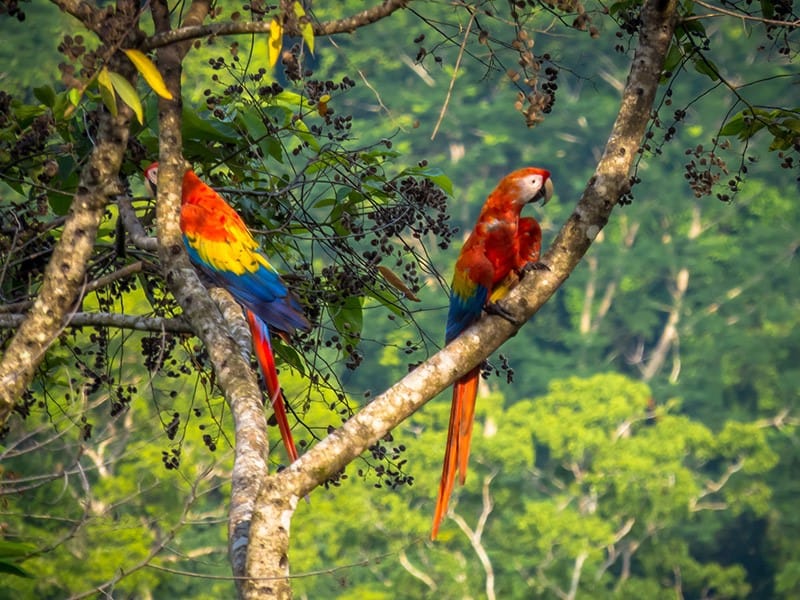
If you are keen to fish this part of the world but would rather enjoy the experience via a traditional lodge-based holiday that’s possible too. Charlotte Chilcott will be hosting a trip to Agua Negra Lodge in Tsimané in July 2024. Full details can be found here. With only four anglers plus Charlotte, this will be a fabulous trip, just pack a sense of adventure along with your fishing tackle. Space is limited so please get in touch as soon as possible if you would like to join her.
If you would like more information please contact Charlotte Chilcott or Olly Thompson or call us on
+44 (0) 1980 847389. Alternatively, click HERE if you would like us to contact you.
About the author: Olly Thompson
